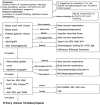The Centenary of Immune Thrombocytopenia-Part 2: Revising Diagnostic and Therapeutic Approach
- PMID: 28871277
- PMCID: PMC5566994
- DOI: 10.3389/fped.2017.00179
The Centenary of Immune Thrombocytopenia-Part 2: Revising Diagnostic and Therapeutic Approach
Abstract
Primary immune thrombocytopenia (ITP) is the most common cause of thrombocytopenia in children and adolescents and can be considered as a paradigmatic model of autoimmune disease. This second part of our review describes the clinical presentation of ITP, the diagnostic approach and overviews the current therapeutic strategies. Interestingly, it suggests an algorithm useful for differential diagnosis, a crucial process to exclude secondary forms of immune thrombocytopenia (IT) and non-immune thrombocytopenia (non-IT), which require a different therapeutic management. Advances in understanding the pathogenesis led to new therapeutic targets, as thrombopoietin receptor agonists, whose role in treatment of ITP will be discussed in this work.
Keywords: chronic thrombocytopenia; conventional therapy; diagnostic algorithm; differential diagnosis; immune thrombocytopenia; new therapeutic targets.
Figures


Similar articles
-
The Centenary of Immune Thrombocytopenia - Part 1: Revising Nomenclature and Pathogenesis.Front Pediatr. 2016 Oct 19;4:102. doi: 10.3389/fped.2016.00102. eCollection 2016. Front Pediatr. 2016. PMID: 27807534 Free PMC article. Review.
-
[Diagnostic approach and treatment of immune thrombocytopenia in adults].Acta Med Croatica. 2013 Mar;67(1):3-11. Acta Med Croatica. 2013. PMID: 24279250 Review. Croatian.
-
Spotlight on romiplostim in the treatment of children with chronic immune thrombocytopenia: design, development, and potential place in therapy.Drug Des Devel Ther. 2017 Mar 30;11:1055-1063. doi: 10.2147/DDDT.S113191. eCollection 2017. Drug Des Devel Ther. 2017. PMID: 28408804 Free PMC article. Review.
-
Use of Thrombopoietin Receptor Agonists in Childhood Immune Thrombocytopenia.Front Pediatr. 2015 Aug 13;3:70. doi: 10.3389/fped.2015.00070. eCollection 2015. Front Pediatr. 2015. PMID: 26322297 Free PMC article. Review.
-
Romiplostim as a treatment for immune thrombocytopenia: a review.J Blood Med. 2015 Jan 19;6:37-44. doi: 10.2147/JBM.S47240. eCollection 2015. J Blood Med. 2015. PMID: 25632241 Free PMC article. Review.
Cited by
-
Misdiagnosed thrombocytopenia in children and adolescents: analysis of the Pediatric and Adult Registry on Chronic ITP.Blood Adv. 2021 Mar 23;5(6):1617-1626. doi: 10.1182/bloodadvances.2020003004. Blood Adv. 2021. PMID: 33710335 Free PMC article.
-
Immune Thrombocytopenia in Children: Consensus and Controversies.Indian J Pediatr. 2020 Feb;87(2):150-157. doi: 10.1007/s12098-019-03155-4. Epub 2020 Jan 11. Indian J Pediatr. 2020. PMID: 31927692 Review.
-
Autoimmunity in Primary Immunodeficiency Disorders: An Updated Review on Pathogenic and Clinical Implications.J Clin Med. 2021 Oct 15;10(20):4729. doi: 10.3390/jcm10204729. J Clin Med. 2021. PMID: 34682853 Free PMC article. Review.
-
Screening for Genetic Mutations for the Early Diagnosis of Common Variable Immunodeficiency in Children With Refractory Immune Thrombocytopenia: A Retrospective Data Analysis From a Tertiary Children's Center.Front Pediatr. 2020 Dec 3;8:595135. doi: 10.3389/fped.2020.595135. eCollection 2020. Front Pediatr. 2020. PMID: 33425813 Free PMC article.
-
Refractory immune thrombocytopenia: Lessons from immune dysregulation disorders.Front Med (Lausanne). 2022 Sep 20;9:986260. doi: 10.3389/fmed.2022.986260. eCollection 2022. Front Med (Lausanne). 2022. PMID: 36203772 Free PMC article. No abstract available.
References
-
- Rodeghiero F, Stasi R, Gernsheimer T, Michel M, Provan D, Arnold DM, et al. Standardization of terminology, definitions and outcome criteria in immune thrombocytopenic purpura of adults and children: report from an international working group. Blood (2009) 113(11):2386–93.10.1182/blood-2008-07-162503 - DOI - PubMed
Publication types
LinkOut - more resources
Full Text Sources
Other Literature Sources

